Riding the Trans-American Trail: A Q&A with Dan Burns
An Inside Look at Tackling America’s Ultimate Off-Road Route
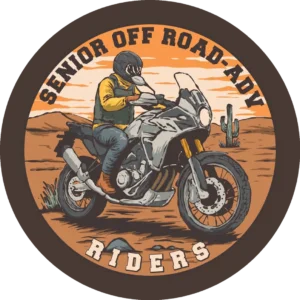
In mid-2024, I, along with most of our group, eagerly followed Dan Burns’ journey along the Trans-American Trail. Each day, we looked forward to his updates, filled with stories from the road and stunning photos of the ever-changing scenery across the country. Like many others, I couldn’t wait to see where the next day would take him.
When we began putting together articles for the website, Dan’s adventure was the first story I knew had to be featured. I’m incredibly grateful he took the time to answer a few questions about his experience.
Take a moment to read Dan’s reflections and insights from this unforgettable cross-country trip.
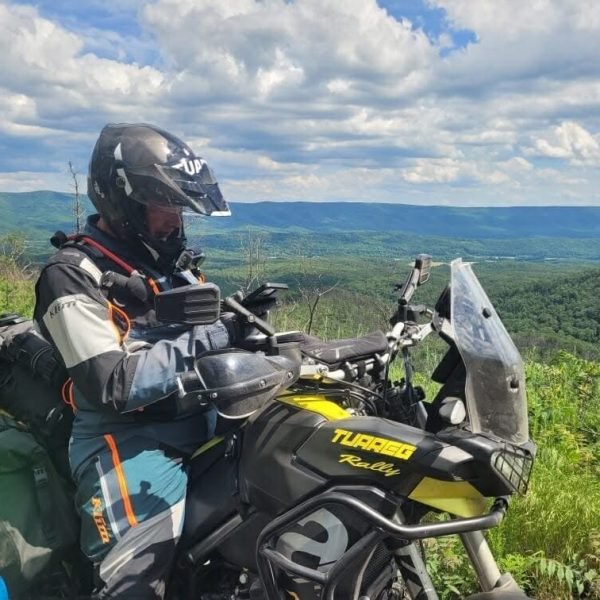
My take of the Trans America Trail and how I got here…
Tell me about yourself — when did you start riding, and what got you into it?
A brief history of how and why I became an Adventure rider.
To start, my motorcycling started about the time I was 10 or 11. Most of the kids in the neighborhood had minibikes of one form or another, and if you didn’t, the ones who did were more than happy to share. I really didn’t have a “motorcycle” (gears and a clutch) until I was 11 when my dad bought me a Hodaka Ace 90. About the time I was a freshman in high school I bought a Yamaha 180 “scrambler”. Upon getting my permit at 15 I left all thoughts of dirt riding behind. I wanted to be a road racer! To that end I proceeded to “Cafe” out the bike. Clubman bars, homemade rear sets, Dunstall seat, ETC. That was the first of a few bikes I had during high school. Others included a Kawasaki H I, Kawasaki H II, and a BSA Rocket III, that I promptly modified for a more road race ride. While others wanted to emulate “Easy Rider” I wanted to be Pat Hennon, Jim Redman or any of the other riders that graced the pages of the cycling magazines.
Alas, the government had another plan for me. 9 days after graduating high school, I spent the next years seeing the world from the top of a main battle tank.
Fast forward to after the Army, college, marriage, and having a job that would support a wife, mortgage and allow me to dabble my feet into racing I got my chance to actually road race. I spent the next decade or so racing club races and the occasional AMA events across the country. I raced everything from Honda Interceptors, GSXR’s, TZ 250’s, Ducati 888’s and other bits over that decade. No, I wasn’t great, but I was good. I didn’t lead many first laps, but I did manage to lead a number of last laps.
While I always had motorcycles, I had no interest in the dirt until I hit my 50’s. For whatever reason I thought it would be fun to try enduro riding. So, off to the KTM dealer for a 300 XCW. I did enduros for several years without any real success other than breaking a few more bones. Remember, I had zero off road experience!
By now our daughter was grown and raising a family of her own, my wife was no longer riding, and I happened to see “Long Way Round” my wife said that looked “interesting”. Enough said! I promptly ran down and traded my Ducati 996 SP in for a new KLR and a check!
And the adventure began.
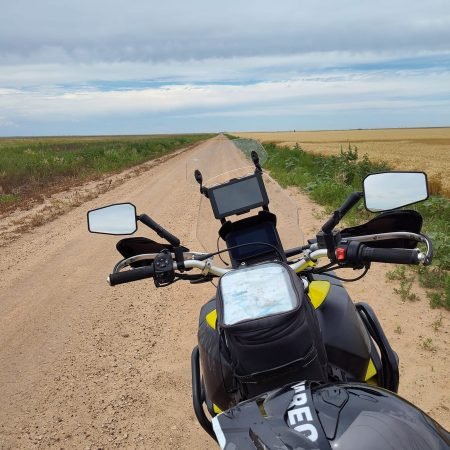
What inspired you to take this cross-country trip in the first place?
It would be easy to say it was in the natural progression of things, or “because it was there”, “I wanted the challenge,” or any myriads of reasons. Honestly, for me, to this day I couldn’t tell you why I did it. Maybe it was because I could? Meh, who knows…
What was your route, and how did you plan or decide on it? What kind of bike and gear did you take, and how did it perform along the way?
For the Trans America Trail I only had two goals, ok, three.
- I was riding the bike start to finish, no shipping, no trailer.
- I was riding coast to coast to coast, camping as much as possible.
- I planned on doing it solo.
I rode Sam’s route predominantly. Sam did the original, he deserves the credit and to that end, I did his route.
I did the TAT (Trans America Trail) on an Aprilia Tuareg 660. I’m not going to get into bikes, other than the Aprilia ran like a watch the entire 10,200-mile trip. Comments like “it’s too heavy, it’s too big, no dealer network” don’t fly with me. If it breaks, fix it, if you drop it, pick it up, get over it. The Aprilia was Steller the entire trip.
As for gear, all in, without water I carried about 46-48 lbs. including bags. This included 5 changes of under clothes to be worn under the KLIM Dakar kit I had purchased for the trip, rain gear, a sleeping bag, air mattress, 2-man tent, food for 5 days (freeze dried), a Jet Boil, a 6-liter water bladder and a hydration pack and tools.
For navigation I used a cheap Amazon TFT screen that would Bluetooth to my phone, mounted above the Aprilia factory TFT, and Osmand + Pro for the navigation app, again using Sam’s GPX files for the actual navigation.
A word about tools. My tool kit weighed in at about 1.6 lbs. I did not carry any spare parts, no tire irons, no tubes, (tubeless wheels). I did carry a SPOT ELT and a first aid kit. Other than needing to adjust the chain, I never touched my tools the entire trip. And about the only maintenance I did was adjust the chain and lube it, changed the oil once in a Western Auto parking lot, and have a new set of tires installed in Trinadad Colorado at about the 7,000-mile mark.
Speaking of tires, I started the trip with a new set of Mitas Non-Dakar E07’s and had a set of Tusk 2 Tracks installed in Colorado. I would have been perfectly happy with another set of Mitas but the rear was not available at the time so I tried out the Tusk 2 tracks for the remainder of the trip, either set of tires would get a 5-star rating from me. Both sets performed excellent in all sorts of terrain.
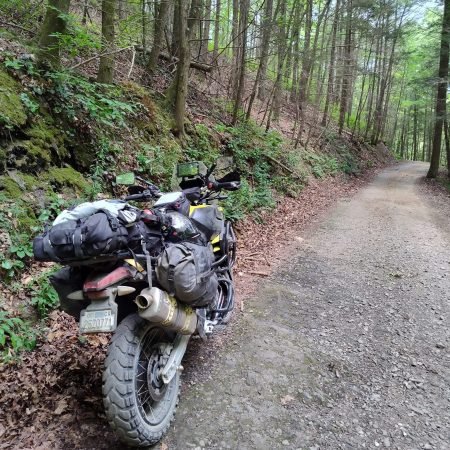
What was the most physically or mentally challenging part of the trip?
For me, the most physical, part of the trip would be the weather. The riding for the most part wasn’t that difficult. Sure, there were some areas that were difficult, but generally due to weather conditions. The rain in Oklahoma made some of the tracks virtually impassable due to mud. The snow and rain in Colorado were below average and the HUMIDITY back east was unbelievable for a poor soul from the central valley of California!
I’d have to say the mental aspect was a bigger challenge. As I rode the entire coast to coast route, plus the 6 days to actually get to the start of the TAT, I found the repetitive grind of setting up camp at the end of the day, breaking down the next morning, for the better part of 6 weeks straight, took the biggest toll. More than once I looked at the map thinking I could bail and be home in a couple days!

Was there a moment or place that completely surprised you — for better or worse?
I’d say that the biggest surprise for me was the outright hospitality of the south. Hands down, I loved riding in the south. The scenery was phenomenal, the humidity sucked, but the riding was excellent. As for the most “memorable” ride? Mississippi, I don’t know if it was that section, the track, the weather, I don’t know, but I really enjoyed Mississippi.
Were there any people you met or moments you experienced that really stuck with you?
I have to say that if the weather is the biggest obstacle of the TAT, the people are the best.
From the two retired Georgia police officers and their wives in the two rooms down from me in Nags Head, (we talked until midnight two nights in a row and I’m still not sure I understood a word of what they said), to what seemed like everyone in a tiny little berg in Mississippi where I stopped for a cup of coffee thinking I’d be there for 15 minutes, then leaving 2 and a half hours later after talking to everyone from the propane delivery guy, the only cop in town, I can’t remember how many farmers and laborers, delivery drivers and anyone getting gas. It was crazy how many folks just wanted to chat about the trip.
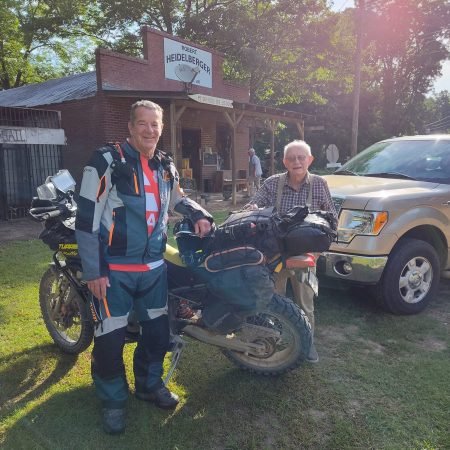
What did you learn about yourself — or about riding — from this journey?
I don’t know that I learned much about myself or about riding from riding the TAT. Maybe that I don’t like camping for 6 weeks straight? I don’t know. I’m of the opinion that if you are willing to undertake something like the TAT you are probably confident in your ability and in yourself.
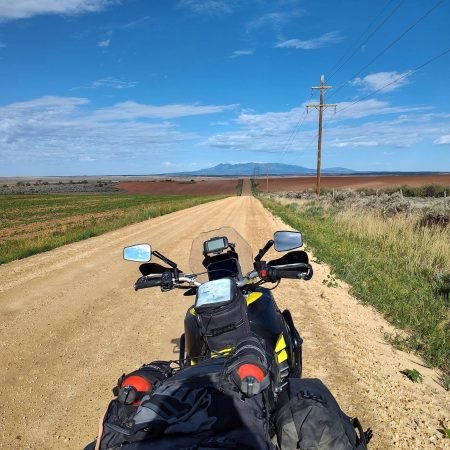
If you could do it again, what would you change or do differently?
If I were to do it again, I wouldn’t change a thing. The memories and experiences I had were significantly above average. I loved the route, and I certainly enjoyed the people along the way.

Any advice you’d give to other riders—especially seniors—thinking about a big ride like this?
Now, writing this, I look back at where and what I have done with adventure riding and find that I have spent more time doing it than any other form of riding. I discovered Back Country Discovery Routes early on in my adventure bike life. I did my first BDR, Utah on the KLR, Subsequent BDR’s include Arizona, Idaho, New Mexico, Nevada, Wyoming, Colorado, and parts of Oregon. (long story about Oregon) and the good Lord knows how many other multi day off road rides.
My adventure bikes have included the KLR for 12,000 miles, a KTM 990 for a bit over 50,000 miles, a Moto Guzzi Stelvio for 55,000 miles and finally an Aprilia Tuareg 660 which had about 26,000 miles on it when I sold it.
The only advice I have for anyone wanting to give this or any other multi day/week ride is do it. You don’t know what you don’t know. Be honest in your assessment of your skill set, the type of bike you’re riding, plan and go. There will ALWAYS be someone with an opposing view. What bike to ride, what tires to use, how many miles to cover in a day, blah, blah, blah. I can’t tell you how many people said “I’d never, use, not take, own…” they are probably right, they never.
I rode an obscure motorcycle brand with virtually no dealer network; I carried a minimum number of tools and no spare parts and made no reservations.
I rode 10.200 miles with the temps as low as 28 F and as high as 114 F, in one swoop. I did not have any flats, no mechanical or electrical issues. And I never dropped the bike.
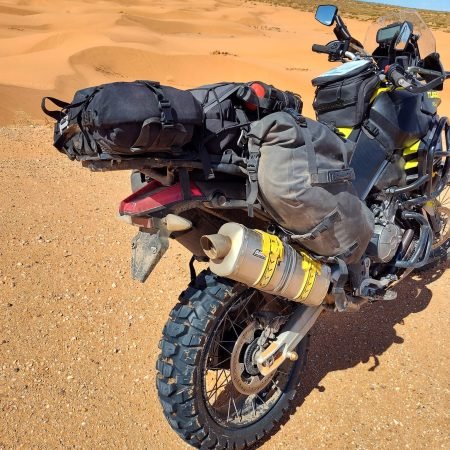
I rode within my limits and didn’t do “stupid” things, partly because I was a long way from home, and partly because my wife would kick my butt.
You never know who you will meet under the overpass out of Green River, or who you’ll come across in Arkansas.
Start to finish my trip was 10,200 miles, 6,000 miles off road and 43 days long. At the time of my ride, I was 69 years old.
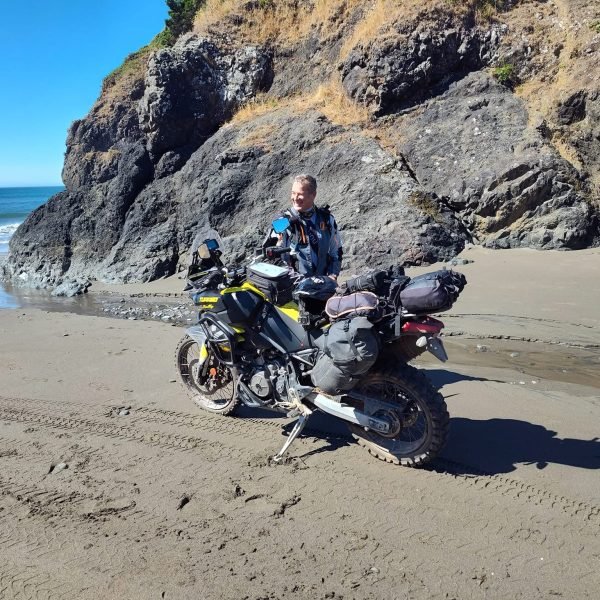
It’s your ride, make it your ride.
-Dan Burns
